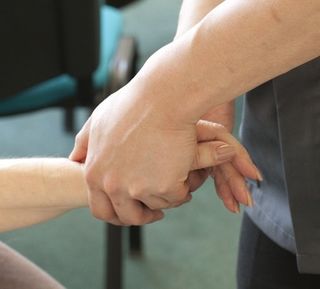
Photo courtesy KampfnerPhotography/ The General Osteopathic Council
BACKGROUND INFORMATION
Why see an osteopath?
As osteopaths we aim to adopt a thorough, caring and wholistic approach to your health and physical well being. Osteopaths do not look on patients as e.g. just back pain sufferers, but rather as individuals with their own unique requirements for health. Treatment is directed to restore as much normal biomechanical function as possible and, in combination with specific advice and exercise, to engage the body's own natural healing processes.
Osteopaths do not simply treat the symptoms but also try to identify as many of those factors contributing to a disturbed state of natural health as is possible. In practice many people will consult an osteopath complaining of common musculo-skeletal conditions affecting muscles, joints and nerves e.g. low back pain, lumbago, sciatica, frozen shoulder, knee pain as well as arthritic pain and muscle stiffness or spasm.
Osteopaths are often able to play a role in aspects of the management of other more chronic conditions, especially those conditions which have effects on the musculo-skeletal system. Injuries caused by sporting activities and work related disorders are also areas where osteopaths may have a role and many patients find treatment can reduce the after effects of stresses imposed on the body by e.g. both pregnancy and childbirth
What do osteopaths treat?
Osteopathy is a form of manual medicine, all osteopaths are trained to a high level in basic medical sciences and physical diagnosis. Treatment, when appropriate, is directed to improving the function of nerves, muscles, ligaments, and joints, which in turn may have profound effects on your overall body function. This is often achieved through gentle mobilisation of these structures and by advising on diet, lifestyle and exercise. The aim is not just short term improvement, but long term change, if possible without continued reliance on treatment by the osteopath.
How many times will I have to see the osteopath?
There are many different reasons why people are in pain and each person has a different way of responding to it. As a general rule acute conditions tend to respond to change relatively quickly, with more chronic conditions taking a little longer to resolve. A typical number of visits would be in the region 2-5, unless long term treatment of a chronic condition is necessary. It is the policy of this practice that if you do not respond to your treatment we will discuss other alternatives and try to find an approach that may be more suitable for you, or refer you for further tests or investigations if appropriate.

Photo courtesy KampfnerPhotography/ The General Osteopathic Council
Are there any side effects?
The main aim of treatment is to restore normal function and to reduce pain and discomfort. Any treatment procedure may possibly create unwanted or additional or 'side' effects. Osteopathy is no different in this respect, but fortunately these 'side' effects are usually very mild. Medico legally we are obliged to advise you of any usual and associated serious adverse effects associated with treatment, however rare.
There are a few things to bear in mind:
Not everyone has a treatment reaction (up to 50% in one study)
The most common reaction is mild local discomfort and tiredness lasting up to 24 hours or so.
These effects seem more common after the first visit and less so thereafter
Specifically, and only with manipulation of the neck, there is an associated, but rare, serious risk of damage to the neck arteries and possible stroke. However, it is important to note that no one study has shown osteopathic manipulation to be directly causative, and also that a variety of studies have shown neck movements generally may create this same risk. (looking up whilst decorating or gardening for long periods and visiting the hairdresser, for example, may all heighten risk)
Although there are difficulties in estimating any risk, studies indicate that this risk certainly appears to be very low and has been estimated to be anywhere from 1 in 100,000 to 1 in 6 million. This is a very low risk and needs to be placed in the context of the risk from everyday activities
Of further interest is that previous research has indicated that the arteries in the neck do not appear to undergo any more strain in manipulative treatment than they do in normal everyday neck movements.
Osteopaths are trained to minimise this risk still further by conducting a thorough case history and examination in order to identify any warning signs of increased vulnerability.
It has to be remembered that millions of neck manipulations are carried out every year by highly trained osteopaths with the main outcome being improvement in pain levels and mobility.
Your osteopath will not recommend neck manipulation if there is any doubt as to the suitability or safety of the technique in your particular case.
Our osteopaths are keen to do their very best to resolve your discomfort and if recommending treatment, they will be happy to discuss any usual or associated serious risk with you. They will only carry out treatment with your full, and infomed consent. Although we are experts in the application of focussed and specific techniques you are free to express your own preference from the choice of technique available. Osteopathy is more than just spinal manipulation. If you would like to discuss these issues further please email us for more information.

Photo courtesy KampfnerPhotography/ The General Osteopathic Council
What is the difference between an osteopath and a chiropractor?
Both osteopaths and chiropractors tend to treat similar conditions with broadly similar techniques. Both professions undergo rigorous training and are obliged to undertake continuing professional development. Although the level of undergraduate and post graduate training for both professions is similar, some chiropractors in the UK refer to themselves as 'doctor'. Osteopaths, even if they hold a research doctorate, tend to avoid using this title as it may erroneously imply that the individual is a medical doctor.
Each profession is state regulated by an overseeing professional body; the General Osteopathic Council and the General Chiropractic Council respectively.
Both professions share a common history and philosophy which initially set them apart from the more traditional allopathic medical fields. Rather than focusing on the individual component parts of the body, osteopaths and chiropractors both view the body in a holistic manner, as a self-contained, self-healing, fully interconnected unit. The first proponent of this philosophy, Andrew Taylor Still, is credited with founding osteopathy in America in 1874. Just twenty-one years later, Daniel David Palmer, thought to be a former student of Dr. Still, founded the chiropractic discipline.
Chiropractors traditionally utilised more direct and swift technique to treat 'subluxation' of the spine, whilst osteopaths traditionally adopted greater use of less direct and less forceful leverage and soft tissue techniques to restore normal function when possible, as well as the cranial approach.
Neither profession is stuck in the past however, and as with modern medicine, ideas and approaches have changed considerably since the time of these early pioneers. Both professions, although proud of their history, are keen to integrate the latest research and evidence based practice into their work.
It is important to remember that both chiropractors and osteopaths address the same neuro-musculo-skeletal structures and use similar manipulative techniques. Traditionally osteopaths tended to work on soft tissues as well as joints, although many chiropractors also adopt this approach. One major difference was that chiroprators would take and utilise x-ray investigation more than would be typical for osteopaths, however, as the risks of ionising radiation became evident, and guidelines were published, fewer chiropractors now routinely use x-ray investigation.
There are always variations between individual practitioners of both disciplines, from what they focus on, to how they apply treatment. Every chiropractor and osteopath develops their own individual style of practice, and it is important for a patient to find a practice that fits his or her unique needs, regardless of the 'label'.